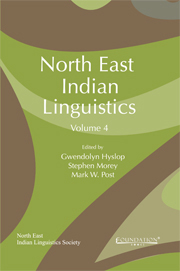Book contents
- Frontmatter
- Contents
- About the Contributors
- Foreword
- A Note from the Editors
- History, Contact and Evolution
- 1 On the Origins of Bodo-Garo
- 2 The Stammbaum of Boro-Garo
- 3 Variation in the Order of Modification in Tai Ahom: An Indication of Historical Boro-Garo Influence?
- 4 The Nominalizing Velar Prefix *gV- in Tibeto-Burman Languages of Northeast India
- Bodo-Garo Grammar
- Orthography, Poetics and Text
- New Descriptions
- Classifiers
- Eastern Indo-Aryan Grammar
- Austroasiatic
1 - On the Origins of Bodo-Garo
from History, Contact and Evolution
Published online by Cambridge University Press: 05 May 2013
- Frontmatter
- Contents
- About the Contributors
- Foreword
- A Note from the Editors
- History, Contact and Evolution
- 1 On the Origins of Bodo-Garo
- 2 The Stammbaum of Boro-Garo
- 3 Variation in the Order of Modification in Tai Ahom: An Indication of Historical Boro-Garo Influence?
- 4 The Nominalizing Velar Prefix *gV- in Tibeto-Burman Languages of Northeast India
- Bodo-Garo Grammar
- Orthography, Poetics and Text
- New Descriptions
- Classifiers
- Eastern Indo-Aryan Grammar
- Austroasiatic
Summary
The phenomenon of Bodo-Garo
Bodo-Garo is a compact, low-level branch of Tibeto-Burman. That is to say, it includes a relatively small number of languages – perhaps a dozen, depending on how we define “language” – which are very similar to one another in their lexicon and grammatical structure. For a small, compact branch, it is spread over quite a large geographical area – and, before the expansion of Assamese and Bengali, certainly over an even larger one. Bodo-Garo languages are spread over a wider area than, say, Naga or Kiranti, each of which is considerably more linguistically diverse than Bodo-Garo. My purpose in this paper is to outline a proposal for the history of the Bodo-Garo branch of Tibeto-Burman which accounts for these facts, as a contribution to our understanding of Bodo-Garo as part of Tibeto-Burman and as a participant in the long-running story of intense language contact in the Brahmaputra Valley.
Briefly, I propose, following a suggestion of Burling (2007), that Proto-Bodo-Garo first emerged as a lingua franca used for communication across the various linguistic communities of the region, and that its striking simplicity and transparency reflect a period when it was widely spoken by communities for whom it was not a native language. In this paper I will first describe the relevant phenomena of Bodo-Garo and its Tibeto-Burman relatives. In §2 I will discuss how the facts of Bodo-Garo fit into various models of language change and differentiation. §3 will briefly review what can be said or imagined about the ethnolinguistic history of Assam and the Brahmaputra Valley. Finally, §4 will summarize my specific proposal for the origin of the Bodo-Garo branch.
- Type
- Chapter
- Information
- North East Indian Linguistics , pp. 3 - 20Publisher: Foundation BooksPrint publication year: 2012
- 3
- Cited by



